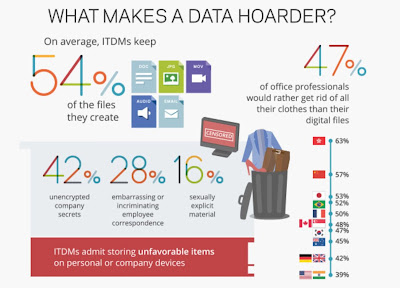 |
| Source: Veritas infographic. More than two thirds of office professionals give up on organising their files. |
Veritas Technologies, the information management provider, has released research* showing that 79% of IT decision makers (ITDMs) in Singapore admit they are hoarders of data and digital files.
Following its Data Genomics project, which analysed tens of billions of files and their attributes from many of its customers’ unstructured data environments, Veritas conducted a study to analyse the data storage habits of ITDMs and global office professionals.
 |
| Source: Veritas infographic. What makes a data hoarder? |
The research, commissioned by Veritas, was conducted among office professionals and ITDMs globally, with 1,000 respondents from Singapore, to look into how individuals manage data. Significant concerns regarding data hoarding were highlighted, with 82% of all respondents indicating that they store data that could be potentially harmful to their organisations.
These include: unencrypted personal records, job applications to other companies, unencrypted company secrets and embarrassing employee correspondence. Major issues highlighted in the research include:
The findings highlighted that digital hoarding ITDMs keep 52% of all the data they create. They also concede that the oldest files on their computers are six years old, on average.
While this indicates that data hoarding behaviour is common across organisations, many office professionals, 57%, admit that they wouldn’t trust a data hoarder to turn in a project on time, higher than the global average at 48%. And nearly one in three (32%) digital hoarding office professionals have never followed through on a plan to delete old files.
Respondents are also willing to do the unexpected in order to keep the files they’ve hoarded, giving up their clothes and weekends rather than deleting their files. Close to half (45%) would rather get rid of all their clothes than their digital files while 37% would rather work weekends for three months than get rid of all their digital files.
A significant majority of ITDMs were also overwhelmed by the extent and amount of data that they are hoarding. However, while 76% of ITDMs feel that digital hoarding is one of the biggest IT problems at their company – 86% said they feel that non-IT executives don’t understand how big of a problem it can be.
More than three quarters (77%) of ITDMs frequently have to take time away from their daily responsibilities at work to solve problems caused by digital hoarding – and on average, they encounter four issues per week. On average, ITDMs feel that 44% of the employees at their company are digital hoarders, whereas 70% of office professionals self-identify as digital hoarders. What is clear is that employees struggle to determine if data has long-term importance or value. As a result, 47% of them are afraid they will eventually need to refer to the data again and they are not sure which files should be kept or deleted.
The amount of data their company stores would increase the time it takes to respond to a data breach, according to 83% of ITDMs. Moreover, what is being retained could itself be harmful, with 73% of office professionals and 91% of ITDMs in Singapore admitting they save ’harmful’ files – which is significantly more than office professionals (62%) and ITDMs globally (83%). These include: unencrypted personnel records, job applications to other companies, unencrypted company secrets and embarrassing employee correspondence. Personal files also make up quite a bit of the ‘junk’ saved, with 91% of ITDMs admitting to saving unnecessary personal files.
In May 2018, the European Parliament will implement the European General Data Protection Regulation (GDPR), a set of EU-wide laws that also affect those outside the EU doing business
within it. Maximum non-compliance fines are at the higher end of US$22.3 million, or up to f4% of worldwide turnover.
“As Singapore moves towards becoming a digital society, virtually every organisation struggles with the challenges brought on by exponential data growth. As a result, office professionals and IT departments have the tendency to safeguard all the information on hand for ‘potential’ use in the future,” said Victor Cheng, MD, Asia South Region, Veritas. “To make matters worse, employees do not view data hoarding as a threat, thus placing data cleanup on the low priority list. It’s time to make data cleanup a priority while causing minimal disruption within the organisation in order to prevent breaches in the future.”
Interested?
Explore the Data Genomics Index
View the complete data hoarders infographic
*This research was conducted by Wakefield Research on behalf of Veritas Technologies across 13 countries and more than 10,000 office professionals and ITDMs.
The Veritas Data Genomics Index is the first data benchmark that accurately details real environments – from the file type composition and average age distribution, to the size proportions of their individual files. Veritas analysed tens of billions of files and their
attributes from many of its customers’ unstructured data environments in 2015 to get a better understanding of what their environments really consisted of. Over 8,000 of the most popular file type extensions were considered in the analysis. Generally, this data is a representative subset of the entire file system environment of a respective customer.
posted from Bloggeroid